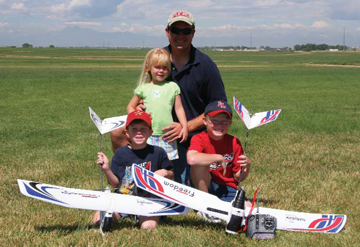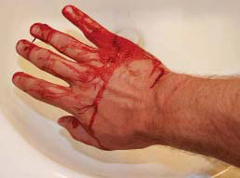As the newest member of the editorial staff of Fly RC magazine, I think I should introduce myself. Many of you will recognize my name from my regular reviews and how-to articles. They will continue, and I have also taken the helm of what I consider to be a very important section of this magazinethe monthly Primary Training column. My aviation background is one of deep involvement in all aspects of RC and full-size flying. As a lifelong RC modeler, airline captain and full-size aerobatics competitor, I find that training with a focus on continual improvement is one of the most important tools we can use to make this great hobby what its supposed to befun!
 With that, I have to ask one question: which kind of pilot and modeler do you want to be? Youd be surprised at the responses that this seemingly simple question elicits. The most common answers include superlatives like good and great. Others answer that question with a very specific goal: they want to be able to hover a model or fly low passes with their warbird. My own answer is that I want to be a safe and competent modeler. To some of you, that might seem so obvious that it goes without saying. Unfortunately, safety can easily be forgotten in the excitement of the moment.
With that, I have to ask one question: which kind of pilot and modeler do you want to be? Youd be surprised at the responses that this seemingly simple question elicits. The most common answers include superlatives like good and great. Others answer that question with a very specific goal: they want to be able to hover a model or fly low passes with their warbird. My own answer is that I want to be a safe and competent modeler. To some of you, that might seem so obvious that it goes without saying. Unfortunately, safety can easily be forgotten in the excitement of the moment.
LETS BE SAFE FIRST
The traditional safety structure of AMA clubs has done a lot to reinforce good safety habits over the years. Unfortunately, with the advances made in electric flight and its often less organized and more isolated nature, we have many up-and-coming pilots who have little, if any, way to learn good safety practices. From time to time I will offer suggestions that will help keep you, your model and, most important, any spectators stay as safe as you can be. This is a great hobby for sharing with younger family members, and it is incumbent upon us to teach younger modelers how to be safe.
Your model airplanes most dangerous part is its propeller. Even the smaller park flyer propellers can cause significant damage, as shown here. In the full-size aviation world, we assume that the propeller can turn at any moment. This is a great approach to dealing with your model airplane as well.
SIMPLE TIPS TO KEEP YOU SAFE
1– Treat every propeller as if it may turn at any moment.
2– Treat every propeller as if it will fail structurally at any moment. Keep all body parts clear of the propeller arc at all times.
3– Remove the propeller from the motor whenever you are doing ESC/motor setup, testing and programming.
4– Properly secure your electric aircraft before you attach any power source; remember, it may start at any moment.
5– Be sure to properly secure your model with a tie-down or have a helper hold it before you start its engine or motor.
6– Between hand-props, give glow and gas airplanes a firm tug to ensure that the tie-down is holding them securely. One of my friends lost a few fingers when his model jumped forwards after starting with a loose tie-down rope.
7– When tuning your engine, you must stay clear of the propeller arc. Preferably, tune the needles with the engine shut down.
8– If its available on your transmitter, use a throttle lock or a throttle kill function to avoid an unplanned application of throttle until youre ready to fly. I use this function religiously but I never trust that it is activated! Check!
9– Always tell spectators not to touch or move your models propeller.
10– Never, ever reuse a damaged propeller. The cost of an injury far outweighs the cost of a new propeller, even if it takes a quick drive to the hobby shop.
11– Keep a first aid kit in your work shop and in your car.
 CONCLUSION
CONCLUSION
Im sure youre wondering about the story behind the photo shown here. Yes, that is my hand; and yes, I failed to heed my own recommended safety practices; in fact, I broke several rules. Ill set the stage for my accident: with a new 3D park flyer resting on the tailgate of my truck, I was preparing for its first flight. My first mistake was to plug the model in when it wasnt secured. After a quick control check, I realized that the rudder channel was backwards, so I entered my radios programming mode with the model still powered up and still unsecuredmistakes 2 and 3. While intending to reverse the rudder channel, I inadvertently reversed the throttle channel, and the model leapt forward and attacked my hand. My initial reaction was one of shock. How could that little propeller have done that much damage?
Racing home with my hand wrapped tightly in a towel (no, I didnt have a first aid kit in the truck), I couldnt help but think of the avoidable consequences of my actions. What if my sons or my daughter had been with me standing next to the model? What if I had been flying a higher-powered model? The model in question was a 150W park flyer turning a 9-inch slowflyer propeller. Imagine the damage a 1500W 16-inch propeller would have done. The best case might have been that I lost a finger or two; in the worst case, Id have lost the use of my hand.
Fortunately, my accident allowed me the opportunity and the clarity required to refocus my personal routine and make my flying as safe as it can be. Following the simple rules given here and focusing on safely when you operate your model will do wonders to keep you and your family and friends safe while you have fun flying or teaching them to fly.
Dont hesitate to contact me with your questions or comments at scotts@ flyrc.com. Lets keep it safe out there, and till next time, remember that learning is fun!
 Fly RC Magazine WE LIVE RC
Fly RC Magazine WE LIVE RC
